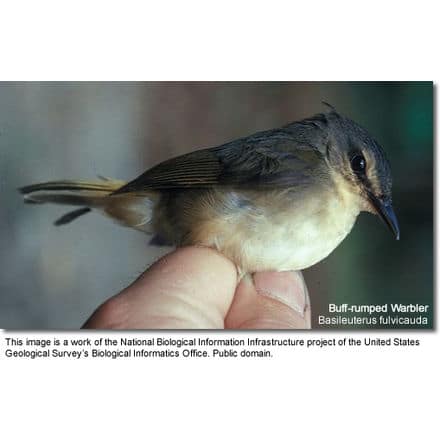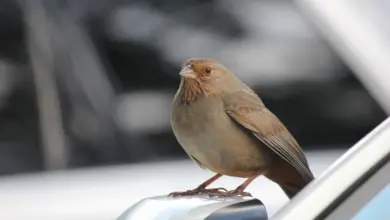Buff-rumped Warblers (Basileuterus fulvicauda)
The Buff-rumped Warblers (Basileuterus fulvicauda) is found in Honduras south to northwestern Peru and western Amazonian Brazil in South America, where it occurs in in forests at up to 1500 m altitude, always near water. It is a common species within its range and is often seen hopping on the ground, pumping and swinging its broad tail constantly.
Recognized Subspecies, Ranges and Identification.

- Basileuterus fulvicauda fulvicauda – Nominate Race
- Range: Western BrazilID: The Buff-rumped Warbler measures 13-13.5 cm in length (including tail) and weighs about 14.5 g. Upper plumage is dark olive-brown with a grey head, buff supercilium (line above eye), and the conspicuous rich buff rump and upper tail from which its common name was derived. The lower half of the tail is blackish. The plumage below is whitish with some buff on the flanks. Males and females look alike. Juveniles have a browner upper plumage, head and breast, and a paler rump.
- Basileuterus fulvicauda semicervina
- Range: Colombia to PeruID: Resembles the nominate race, but the buff area of the tail is larger and paler, and the buff on the flanks is more extensive.
- Basileuterus fulvicauda motacilla
- Range: Various parts of ColombiaID: Resembles the subspecies semicervina (described above), but the buff area of the tail is paler, and the upper plumage is more olive.
- Basileuterus fulvicauda leucopygia
- Range: Caribbean Central AmericanID: Has a much paler buff rump, a white supercilium (line above eye), dark legs, and dark spotting on the chest.
- Basileuterus fulvicauda veraguensis
- Range: Pacific Central AmericanID: Resembles nominate form, but has less spotting and a darker rump.
- Basileuterus fulvicauda significans
- Range: Amazonian PeruID: Less extensive buff rump than other subspecies, and olive upper plumage.
Nesting / Breeding
Both the male and the female build a bulky domed nest with a side entrance on a sloping bank next to a stream or path.
The average clutch consists of two white eggs which are incubated for 16-17 days. The young fledge (leave the nest) when they are about 13 – 14 days old.
Feeding / Diet
The Buff-rumped Warbler mostly feeds on insects, spiders and other small invertebrates (= animals without internal skeleton, such as larvae, earthworms, millipedes, snails), taken on the ground or in flight in open areas along the banks of streams, puddles, roadsides or tracks. Pairs aggressively defend their feeding territories along a stretch of stream throughout the year.
Call / Vocalization
Its call is described as a hard tschik – similar to the vocalization of the Northern Waterthrush.
The male’s song is a warble followed by a series of 8-15 ringing chew notes; and the female may give a soft reply



